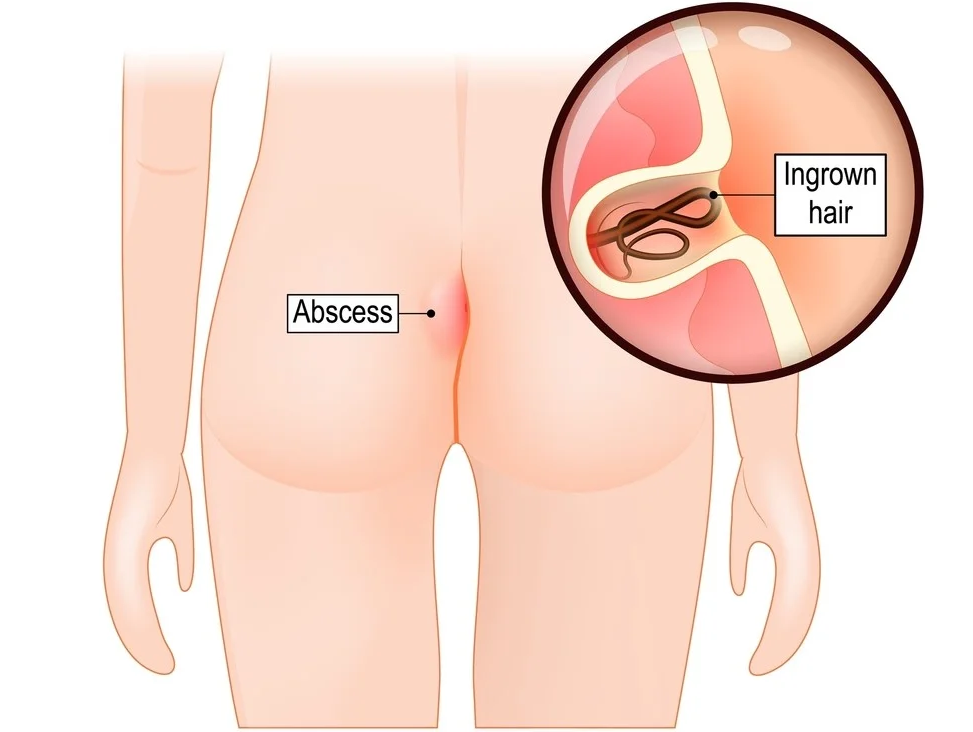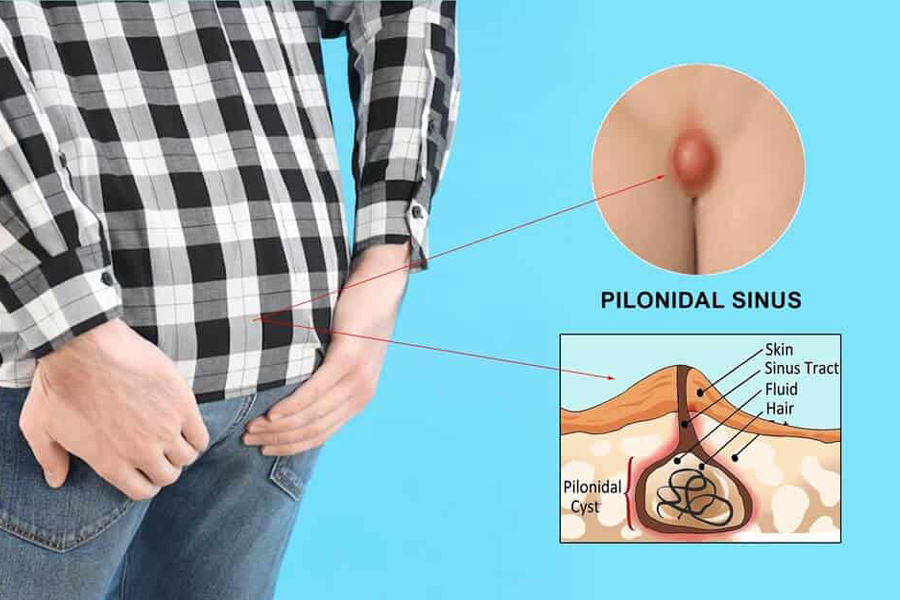Pilonidal Sinus Treatment in Hyderabad
Working Time
- Mon-Thu 10:00 – 20:00
Friday 10:00 – 20:00
Saturday 10:00 – 19:00
Contact Info
-
Phone: +91 88862 41919
Ask the Experts
A pilonidal sinus is a small, abnormal cavity or tunnel that forms in the skin, typically at the base of the spine, near the sacrum. It often contains hair, debris, and other foreign materials. The condition usually develops as a result of ingrown hairs or friction, leading to infection and the formation of a sinus tract. Pilonidal sinuses can cause significant discomfort and may lead to recurrent infections if not treated appropriately. If you are looking for Pilonidal Sinus Treatment in Hyderabad, understanding the causes and treatment options is essential.
Pilonidal Sinus Surgery in Hyderabad
The exact cause of a pilonidal sinus is not always clear, but several factors can contribute to its development. In some cases, Pilonidal Sinus Surgery in Hyderabad may be required to effectively treat the condition and prevent recurrence.
Causes of Pilonidal Sinus
The exact cause of pilonidal sinus is not always clear, but several factors can contribute to its development:
- Ingrown Hairs: Hair growing into the skin can cause irritation and inflammation.
- Friction and Pressure: Prolonged sitting or activities that cause friction in the area.
- Poor Hygiene: Accumulation of sweat and bacteria in the sacral region.
- Genetics: Some individuals may be predisposed to developing pilonidal sinuses.


Symptoms of Pilonidal Sinus
Symptoms of a pilonidal sinus can vary but commonly include:
- Pain and Discomfort: Pain in the lower back or tailbone area, especially when sitting.
- Swelling and Redness: Inflammation around the sinus opening.
- Discharge: Fluid or pus, sometimes with a foul odor, may drain from the sinus.
- Visible Sinus Tract: A small dimple or pit in the skin, which may have hair or debris around it.
- Recurrent Infections: Frequent flare-ups and abscess formation.
Diagnosis of Pilonidal Sinus
Diagnosing a pilonidal sinus typically involves:
- Medical History and Physical Examination: A thorough review of symptoms and a visual examination of the affected area.
- Imaging Studies: Ultrasound or MRI may be used to assess the extent of the sinus tract and identify any abscesses.

Conservative Treatments
In cases where the pilonidal sinus is not severe, conservative treatments may include:
- Antibiotics: To treat or prevent infection.
- Hygiene Measures: Keeping the area clean and dry.
- Pain Relief: Over-the-counter pain medications to manage discomfort.
Surgical Treatments
For more severe or recurrent cases, surgical intervention may be necessary. Options include:
- Incision and Drainage: To relieve infection and abscess formation.
- Excision and Closure: Removal of the sinus tract and closure of the wound with stitches or a flap.
- Laser Treatment: A modern approach that uses laser technology to target and treat the sinus tract with precision.

Advantages of Laser Treatment for Pilonidal Sinus
Laser treatment is an advanced and effective method for managing pilonidal sinus. Here’s why it might be the right choice for you:
- Minimally Invasive: Laser treatment involves minimal incisions, which significantly reduces pain and recovery time compared to traditional surgery.
- Precision: Lasers target only the affected tissue, preserving healthy skin and reducing collateral damage. This precision ensures effective removal of the sinus tract while minimizing harm to surrounding tissues.
- Reduced Pain: Patients often experience less postoperative discomfort due to the less invasive nature of the procedure. This can translate to a more comfortable recovery experience.
- Faster Recovery: Laser treatment generally results in a quicker recovery period, allowing patients to return to their daily activities sooner.
- Lower Risk of Complications: The precision of lasers reduces the risk of infection, bleeding, and other complications commonly associated with traditional surgical methods.
- Effective for Complex Cases: Laser treatment is suitable for treating both simple and complex pilonidal sinuses, including recurrent cases. Its effectiveness in targeting the sinus tract precisely improves overall treatment outcomes.

How Laser Treatment Works?
- Assessment: A comprehensive evaluation is performed to determine the extent and nature of the pilonidal sinus.
- Anesthesia: Local or general anesthesia is administered to ensure patient comfort during the procedure.
- Laser Application: A laser is used to remove or vaporize the sinus tract and any surrounding infected tissue with high precision.
- Post-Treatment Care: Patients receive specific aftercare instructions to ensure proper healing and prevent recurrence. Follow-up appointments are scheduled to monitor the healing process.
Prevention of Pilonidal Sinus
Preventive measures include:
- Maintaining Good Hygiene: Regular cleaning and keeping the area dry to prevent the accumulation of sweat and bacteria.
- Avoiding Prolonged Sitting: Taking breaks and avoiding excessive sitting, which can exacerbate friction and pressure.
- Hair Removal: Regularly removing hair in the sacral area to prevent ingrown hairs and subsequent irritation.
- Wearing Comfortable Clothing: Choosing clothing that reduces friction and irritation in the sacral region.

Faqs For Pilonidal Sinus Treatment
Common symptoms include pain in the lower back or tailbone area, swelling and redness, discharge of fluid or pus, a visible sinus tract or pit, and recurrent infections.
Diagnosis typically involves a medical history review and physical examination. Imaging studies such as ultrasound or MRI may be used to assess the extent of the sinus tract and identify any abscesses.
Conservative treatments, such as antibiotics and hygiene measures, are used for less severe cases. Surgical treatments, including excision and laser therapy, are employed for more severe or recurrent cases to remove the sinus tract and prevent recurrence.
Laser treatment is less invasive than traditional surgery, offering reduced pain, quicker recovery, and fewer complications. It is particularly effective for complex or recurrent cases, providing precise treatment with minimal damage to surrounding tissues.
During the procedure, you will receive anesthesia to ensure comfort. After treatment, you may experience minimal discomfort and can typically resume normal activities within a few days. Your healthcare provider will provide specific aftercare instructions and schedule follow-up visits.
Laser treatment is generally safe with minimal risks. Possible side effects include mild discomfort, temporary swelling, or a minor risk of infection. Your healthcare provider will discuss these risks and take steps to minimize them.
Laser treatment is highly effective for many patients, particularly for those with recurrent or complex pilonidal sinuses. The precision of the laser allows for targeted treatment, improving outcomes and reducing the risk of recurrence.
Recovery time is usually shorter with laser treatment compared to traditional methods. Most patients experience significant improvement within a few days and can return to normal activities relatively quickly.
Conclusion
Pilonidal sinus can be a challenging condition, but with appropriate diagnosis and treatment, it can be effectively managed. Laser treatment offers a modern, minimally invasive solution with numerous advantages over traditional methods. If you suspect you have a pilonidal sinus or are interested in learning more about laser treatment options, consult with a healthcare professional to explore the best approach for your needs.
For more information or to schedule a consultation, contact us at +91 88862 41919.
